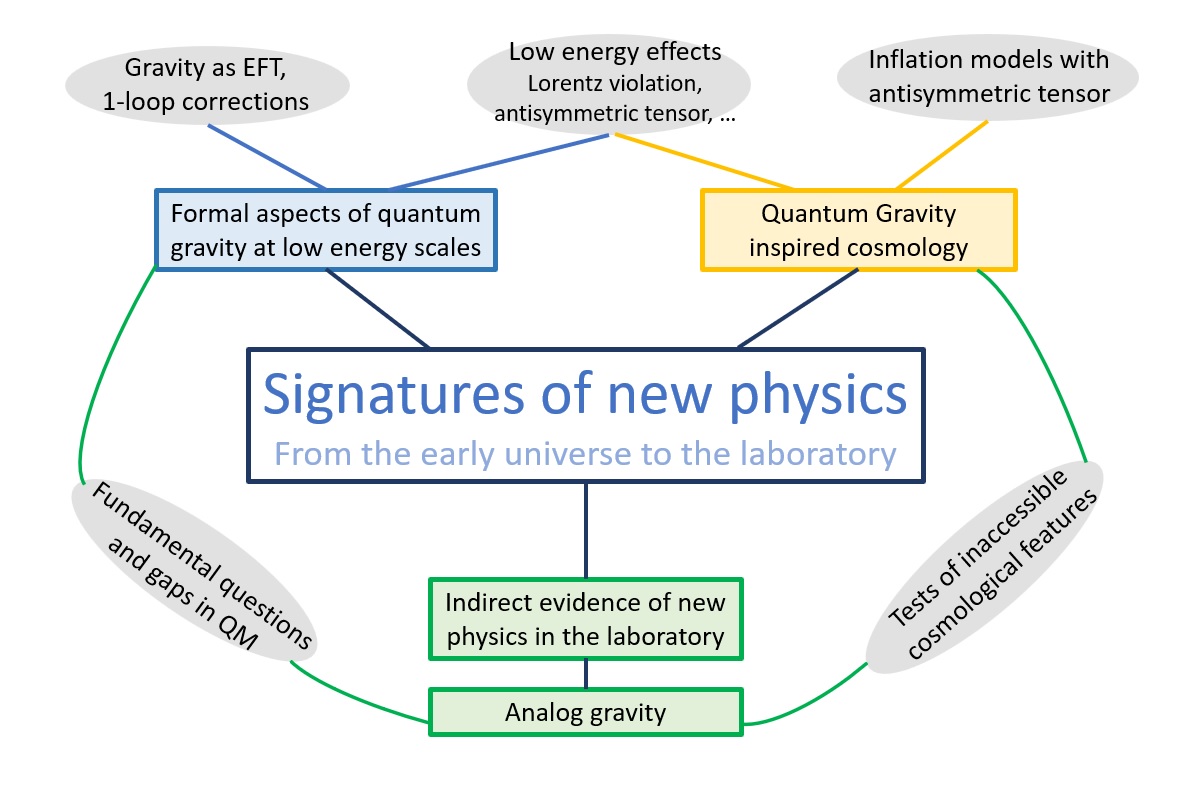Research

We use theoretical and computational tools to investigate the direct signatures of new physics in the early universe, and indirect signatures in laboratory based table-top experiments. Some focus areas that my group at IIT Patna is interested in are listed below.
Cosmological implications of low-energy quantization of gravity using effective field theoretic tools
The problem with perturbative quantization of gravity viz.-à-viz the quantization of other forces in the standard model is the inability to consistently absorb the divergences, giving rise to non-renormalizability. However, in the past two decades or so, a more modern viewpoint has developed where general relativity is treated as a quantum effective field theory at low energies, fueled by the realization that cosmological particle production towards the end of inflation is indeed a quantum gravitational phenomenon that cannot be explained by standard (in-out) quantum field theory. This treatment allows separation of quantum effects from known low energy physics from those that depend on the ultimate high energy completion of the theory of gravity and constitutes the basis of all analysis in this proposal. We are interested in computing the gravitational effective action at one- and two-loop levels for competing inflation models consisting of scalar, vector or tensor fields and analyse vacuum stability conditions for corresponding effective potentials, and studying the origins of higher derivative terms appearing in several phenomenologically interesting models of inflation and modified gravity. In particular, we aim to understand the counterintuitive structure of the Starobinsky inflation model wherein higher order terms expected from the effective field theoretic approach are absent, but the model fits well with observed data.
Lorentz violation, n-forms and other low energy predictions of quantum gravity
A more phenomenological approach involves detecting Planck suppressed variations of standard model and general relativity while maintaining observer independence, termed as standard model extension (SME) pioneered by Kostelecky et. al. One of the effects of SME is the violation of Lorentz symmetry (also called Lorentz violation in literature), which is a fundamental symmetry in general relativity that relates all physical local Lorentz frames. Lorentz violation is predicted by most superstring and quantum gravity models and is considered as one of the candidate signals of Planck scale physics. Although numerous constraints of the SME parameters have been obtained in the astrophysical and short-range gravity sector, studies in the cosmological sector have been limited. Another consequence of string theory, at low energies, is the appearance of a rank-2 antisymmetric tensor field along with a symmetric rank 2 tensor and a dilaton (scalar field) because of compactification of higher dimensions, therefore supporting the multi-field scenario inspired non-gaussianities in the inflationary universe. We are interested in investigating the phenomenological implications of n-forms and Lorentz violation in the inflationary cosmology, which is so far an unexplored question due to lack of relevant data. For example, in a Lorentz violating inflation model what is the three-point correlation function? What effect does including gravitational effective action have? Can non-gaussianities be ruled out as statistical anomalies?
Analogue gravity
The equation of motion of perturbations (acoustic disturbances) on a non-viscous barotropic fluid is equivalent to that of a particle moving in a curved spacetime. This correspondence is at the heart of the analogue gravity research. Over the years, bose-einstein condensates and other quantum fluids have been used to simulate nontrivial spacetimes in laboratory, like the Schwarzschild spacetime near a black hole, FRW spacetime relevant in the inflationary universe, and even Lorentz violating spacetime geometries. We are interested in questions like: can BEC system be used to create an analogue of a closed timelike curve? By simulating a region of such a spacetime, would it be possible to rule in (out) the chronology protection conjecture? Would simulating spacetimes with antisymmetric tensor fields or Lorentz violation in the inflationary universe (corresponding to FRW metric) produce observable clues to confront string theory?
Foundations of quantum mechanics and gravity
There are gaps in our understanding of quantum mechanics, that cannot be reconciled through carefully constructed interpretations. Understanding what is missing (and why) in quantum mechanics, could provide clues for a unified theory. Some of the relevant topics we are interested in are, for example, testing the Hawking’s chronology protection conjecture, time-reversibility in quantum mechanics.